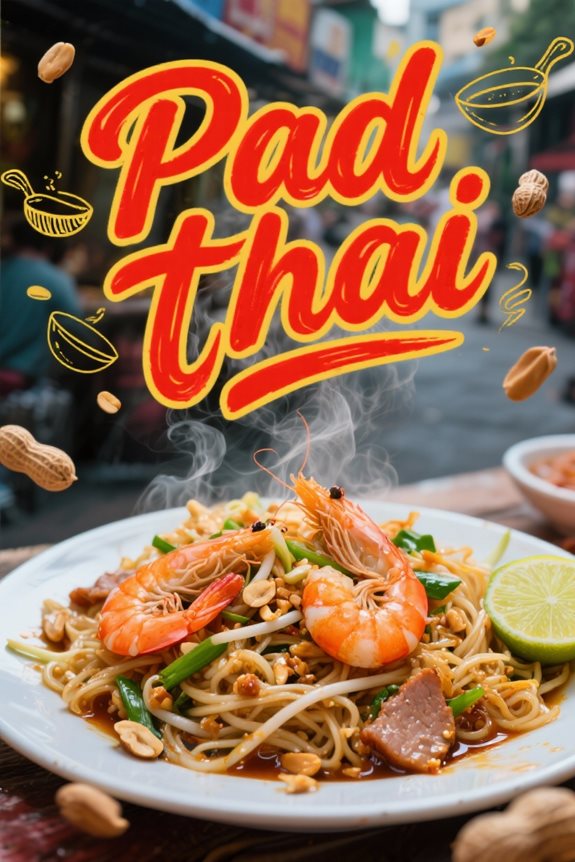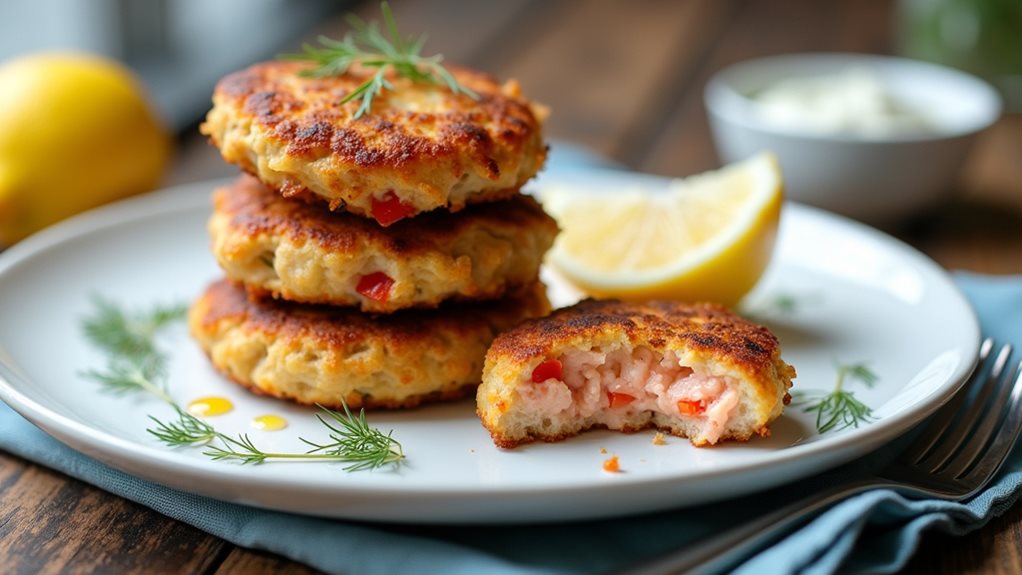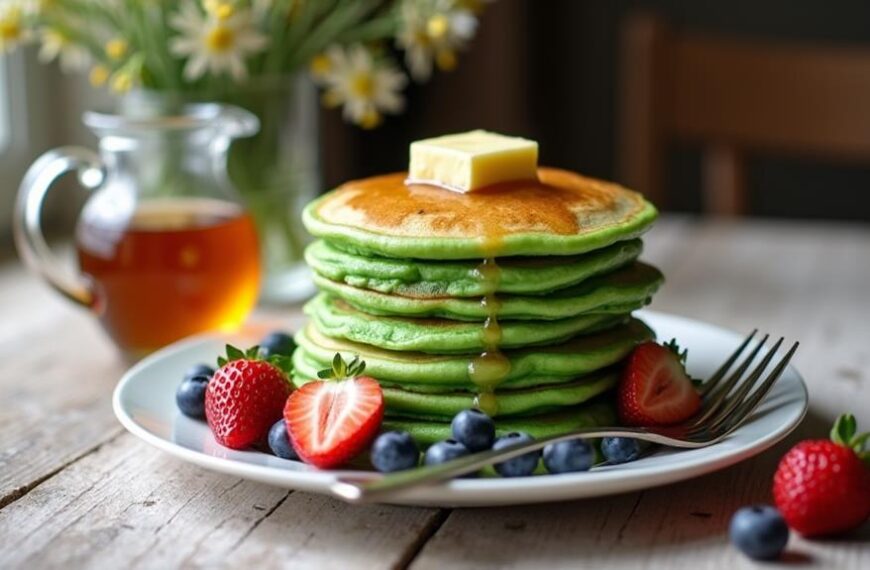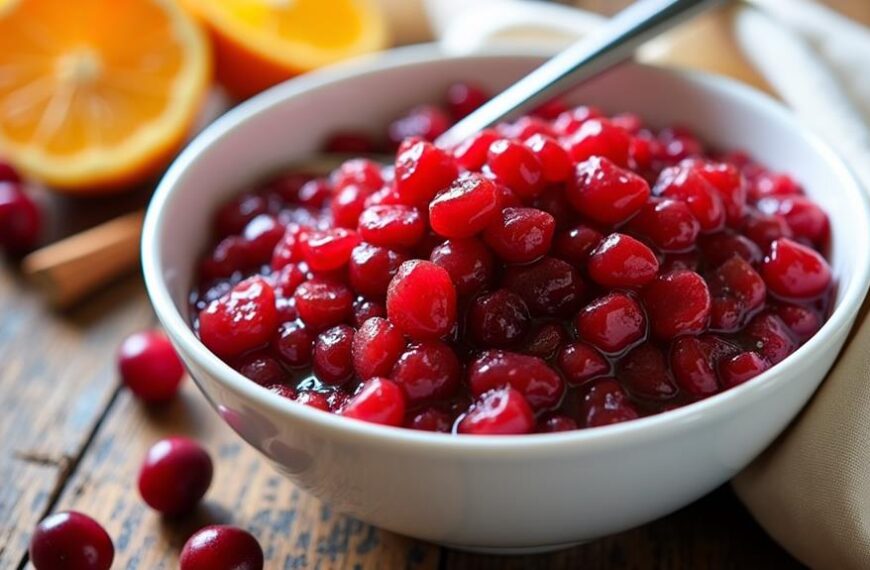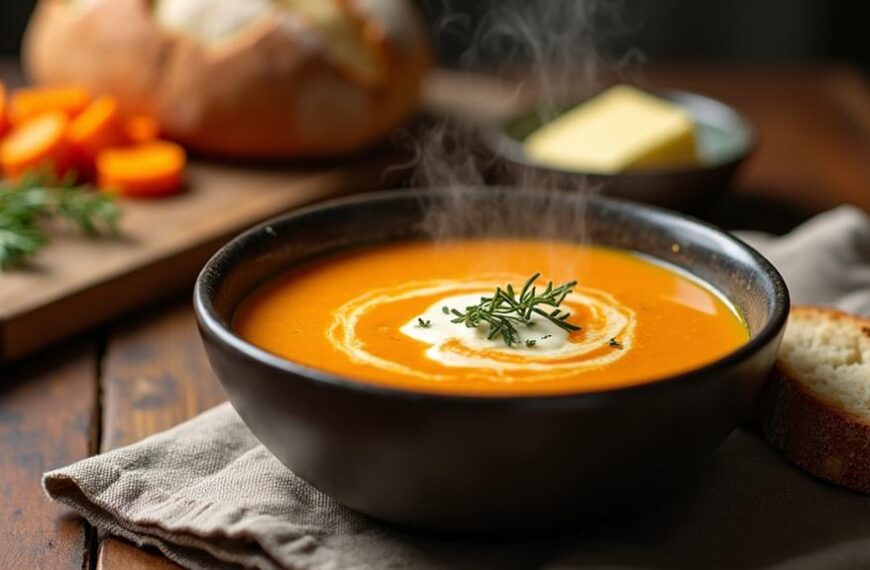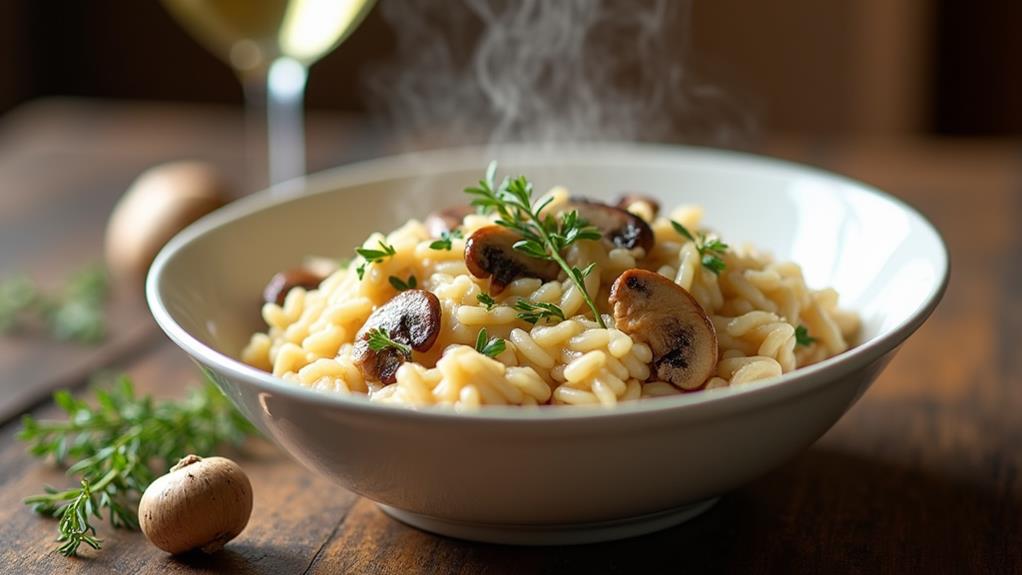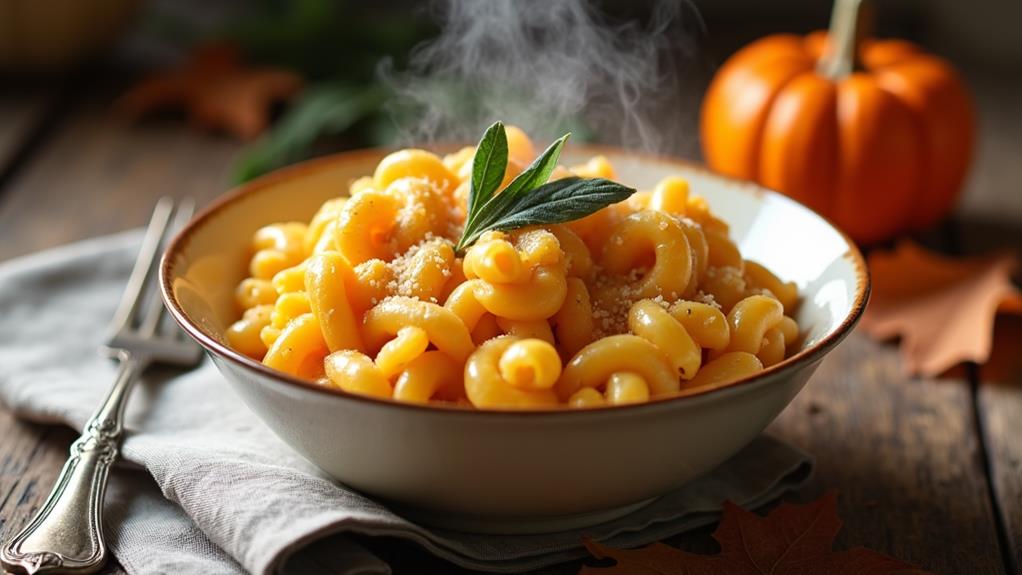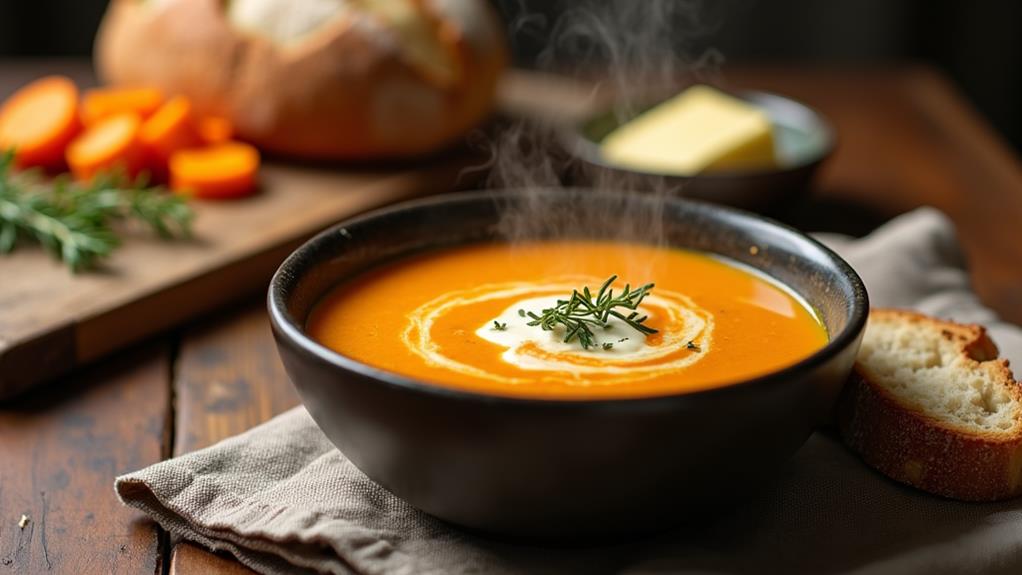I’ve traveled across Thailand, sampling countless versions of Pad Thai, and I’m excited to share my authentic recipe with you. This iconic dish combines the perfect balance of sweet, salty, sour, and umami flavors that dance on your palate with every bite. The secret lies in the sauce and cooking technique, which I’ll show you how to master. Once you’ve tried this homemade version, you’ll never look back to takeout again.
Key Takeaways
- Pad Thai is Thailand’s beloved street food that balances sweet, salty, sour, and umami flavors perfectly.
- Traditional ingredients include rice noodles, fish sauce, rice wine vinegar, protein (shrimp/pork), and fresh garnishes.
- The dish is prepared by stir-frying soaked rice noodles with sauce, protein, eggs, and finished with peanuts and lime.
- Common variations include protein substitutions like tofu for vegetarians and adjustable spice levels with cayenne or Thai chilies.
- Pad Thai is typically served with lime wedges, extra bean sprouts, and pairs well with Thai iced tea or lager.
Why You’ll Love this Authentic Pad Thai
While many restaurant versions might disappoint, this authentic Pad Thai recipe delivers the perfect balance of sweet, salty, sour, and umami flavors that make this dish a Thai classic.
I’ve crafted this recipe to capture the genuine taste of Thailand’s most beloved street food, using traditional ingredients like fish sauce, rice wine vinegar, and fresh lime juice that create that distinctive tangy profile.
You’ll appreciate how the tender rice noodles wrap around succulent shrimp and savory ground pork, while bean sprouts and green onions add vital crunch.
The roasted peanuts and fresh cilantro aren’t mere garnishes—they’re crucial components that contribute both texture and aromatic depth.
I’ve also included just enough cayenne to provide warmth without overwhelming the delicate balance of flavors.
What Ingredients are in Authentic Pad Thai?
Pad Thai is one of Thailand’s most beloved dishes that has captured hearts around the world. This stir-fried noodle dish balances sweet, salty, sour, and umami flavors perfectly, creating a harmonious taste experience that keeps you coming back for more.
Making authentic Pad Thai at home might seem intimidating, but with the right ingredients, you’ll be able to recreate this street food classic in your own kitchen.
- 8 oz. dry rice noodles
- 1/4 cup fish sauce
- 2 Tbsp. rice wine vinegar
- 2 Tbsp. sugar
- 1/4 lb. peeled and de-veined raw shrimp, halved lengthwise
- 1/4 lb. ground pork
- 1/4 tsp. cayenne
- 3 Tbsp. peanut oil
- 3 Tbsp. minced garlic
- 2 large eggs
- 2 cups bean sprouts
- 2 cups sliced green onions
- 1/4 cup chopped roasted unsalted peanuts
- 1/4 cup minced fresh cilantro
- 1 Tbsp. fresh lime juice
When shopping for these ingredients, freshness matters tremendously. The rice noodles should be soaked until just tender, about 45 minutes before cooking.
If you have dietary restrictions, there are adaptations you can make—tofu works wonderfully as a protein substitute for the shrimp and pork. Some home cooks might be tempted to skip the fish sauce due to its strong aroma, but it’s truly crucial for that authentic flavor profile.
Can’t find bean sprouts? Thinly sliced cabbage can work in a pinch, though the texture won’t be quite the same. Remember, the beauty of Pad Thai lies in its balance of flavors and textures, so try to include all the components if possible.
How to Make this Authentic Pad Thai
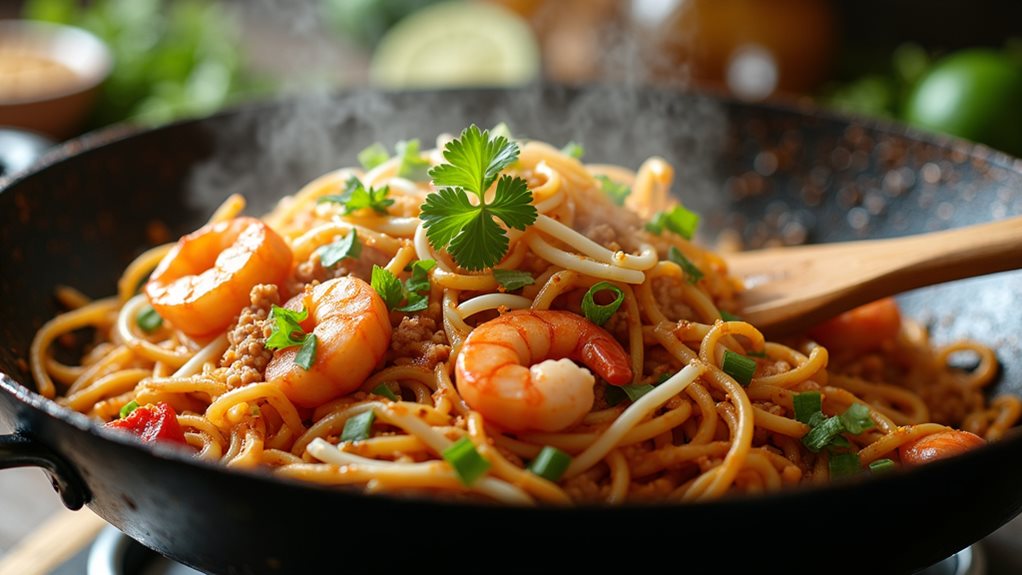
To begin making this delicious Pad Thai, start by soaking 8 oz. of dry rice noodles in water until they’re just tender, which takes about 45 minutes.
While the noodles are softening, you can prepare the sauce by mixing 1/4 cup fish sauce, 2 tablespoons rice wine vinegar, and 2 tablespoons sugar in a small bowl. This sweet-savory sauce is what gives Pad Thai its distinctive flavor profile—tangy, salty, and just sweet enough to balance everything out.
Next, heat 3 tablespoons of peanut oil in a large wok or skillet over medium-high heat. Add 3 tablespoons minced garlic and cook until fragrant, then toss in 1/4 pound ground pork and 1/4 pound halved raw shrimp. Sprinkle in 1/4 teaspoon cayenne for that subtle heat.
Once the proteins are nearly cooked through, push everything to one side and crack 2 large eggs into the empty space, scrambling them until just set. Now comes the fun part—drain those soaked noodles and add them to the wok, pouring the sauce mixture over everything. Toss continuously to coat all ingredients, allowing the noodles to absorb that amazing flavor. I always find this part so satisfying, watching all those elements come together.
For the final touch, fold in 2 cups of fresh bean sprouts and 2 cups of sliced green onions, cooking just until slightly wilted.
Remove from heat and finish with 1/4 cup chopped roasted peanuts, 1/4 cup minced cilantro, and a tablespoon of fresh lime juice. If you enjoy creating culinary masterpieces, consider investing in a luxury pie making set for when you want to try your hand at desserts. The lime really brightens everything up, don’t you think?
Serve immediately while hot, maybe with extra lime wedges on the side. And there you have it—restaurant-quality Pad Thai right at home, with that perfect balance of textures and flavors that makes this dish so universally loved.
Authentic Pad Thai Substitutions and Variations
Although traditional Pad Thai follows specific ingredients and methods, I’ve found that several substitutions can work beautifully when you’re in a pinch or want to customize this classic dish.
If you can’t find rice noodles, soba or even linguine can serve as temporary alternatives. For vegetarians, tofu works wonderfully instead of shrimp and pork, while vegans can skip the eggs entirely and use soy sauce in place of fish sauce.
Don’t have peanuts? Try cashews for a different but equally delicious crunch. Bean sprouts can be substituted with thinly sliced cabbage in a pinch.
For those who enjoy heat, increase the cayenne or add fresh Thai chilies. When lime isn’t available, a splash of lemon juice provides the necessary acidity that makes Pad Thai sing.
What to Serve with Authentic Pad Thai
Accompaniments can improve your Pad Thai experience from simply delicious to truly memorable.
I always recommend serving fresh lime wedges on the side, allowing diners to adjust the dish’s acidity to their preference. A small plate of bean sprouts, cilantro, and chopped peanuts offers textural contrast and lets guests customize their meal.
For beverages, I find that Thai iced tea or a crisp lager perfectly balances the complex flavors.
If you’re creating a full spread, consider starting with tom yum soup or fresh spring rolls. Mango sticky rice makes an ideal dessert finale, counterbalancing the savory notes of your main course.
Remember that simplicity often works best—Pad Thai is already a complete meal with proteins, vegetables, and carbohydrates thoughtfully combined in one spectacular dish.
Final Thoughts
Mastering Pad Thai represents my personal adventure into Thai cuisine’s heart, connecting centuries of tradition with modern kitchens worldwide.
I’ve discovered that the balance of sweet, sour, salty, and umami flavors creates more than just a dish, but an experience that transcends cultural boundaries.
Consider adding a squeeze of fresh lemon to brighten your Pad Thai, as citrus and herbs create an invigorating dimension that elevates the dish’s complexity.
As you set out on your own Pad Thai experience, remember that perfection comes with practice.
Don’t be discouraged by initial attempts that mightn’t match restaurant versions. Each time you prepare this iconic dish, you’ll develop a deeper understanding of ingredient harmony and cooking techniques.
I encourage you to make this recipe your own while respecting its traditional roots.
The beauty of Pad Thai lies in its adaptability while maintaining its crucial character—a reflection of Thailand’s rich culinary heritage.


